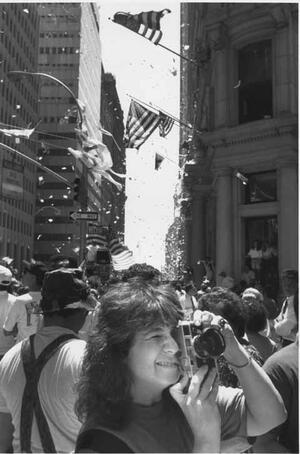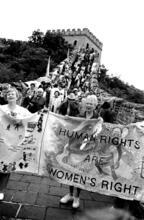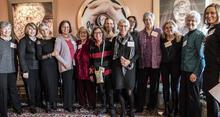Joan Roth
Joan Roth was born in 1942 in Detroit, Michigan, to an observant Jewish family. As a child, Roth was stunned by a photo series in Life magazine by the famous photographer Lisette Model, sparking her interest in photography. In 1968, while living in New York, Roth took a film course at New York University but was advised by a professor to study photography instead. After working for several noted photographers, Roth studied under Model herself, who became her mentor and friend. Roth’s most famous work has involved photographing women. In the 1970s she photographed homeless women living on the streets of New York, and in 1983 she joined rescue missions airlifting Ethiopian Jews to Israel. Inspired by the photographs she took there, Roth traveled to Jewish communities all over the world photographing Jewish women. Her work has received frequent awards and exhibitions.
Overview
“Some journeys travel through space and others through time—some journeys travel through our hearts and these are the longest and deepest journeys of all,” according to Jewish-American photographer Joan Roth, a visual poet who has traveled the world in search of the face of female Jewry. From Ethiopia to Yemen, India, and Israel, Roth’s remarkable life and photographic odyssey is a celebration of the strength and diversity of Jewish women around the world. Feminist Phyllis Chesler says Roth’s “sublime and unrivaled photographs make her the pre-eminent living photographer of Jewish women worldwide.”
Early Life and Education
Joan Roth was born Joan Louise Altman on August 4, 1942, into an affluent, observant Jewish family in Detroit, Michigan. Joan’s mother, Clara June Rubin Altman, born July 8, 1913, in New York City, was descended on her mother’s side from an Orthodox family from Breslau, Germany.
Joan’s father was Albert Jay Altman, born in 1904 in Tarashe, Ukraine ,into a strictly Orthodox family. His father, Nathan Altman, and his mother, Bertha Pliskow, were both born in the Ukraine. Nathan Altman may have been among the last observant Orthodox Jews living in Detroit at a time of religious evolution there. He never learned English, spoke only Yiddish, and followed strict rabbinic laws until his death at the age of one hundred.
Joan’s father became a dentist to whom everyone referred as “Doc,” an observant Jew who treated all his patients, whether they could afford to pay or not. Joan’s mother, who was married to Albert Altman for over thirty years, had four additional husbands after he died in 1963. She died in Detroit at the age of eighty-six on Joan’s birthday, August 4, 1999.
From the age of eight until her junior year of high school Roth attended Hebrew school three days a week, went to Sunday school, and to synagogue with her family every Saturday morning. She grew up with one sister and a brother. Marjorie Ruth Altman Krasnick, born in 1939, is a medical nuclear technologist and an artist. She is married to pharmacist William Krasnick (b. 1936). Roth’s brother, Burton Lee Altman, born in 1936, worked for the City of Detroit for many years until his death in 1996.
Move to New York and Early Photography Work
On September 15, 1963, Joan married Jac Roth (b.1937), in a small wedding ceremony in Joan’s backyard. They moved to New York, where her husband became a businessman and they started a family. Their first daughter, Melanie Jo Roth Gorelick, who was born in 1964, worked for the United Nations Development Fund for Women, and has two daughters. Joan’s second daughter, Alison Jae Roth, who was born in New York in 1966, has a master’s degree in social work, worked for the Thalians at Cedars-Sinai Medical Center in Los Angeles, and ran the Teen Suicide Hotline there for six years. Roth says, “Both daughters are independent, strong, capable Jewish women with great depth. I am very proud of and have great respect for them and their endeavors.” Joan and Jac were divorced in 1971.
When Roth was a girl she was stunned by a series of photographs she had seen in Life magazine showing pictures of legs, taken at a low camera angle, close to the camera—the famous series Running Legs by photographer Lisette Model (1901–1983). In 1951 this brilliant Viennese-born artist was invited to teach at the New School for Social Research in New York, where her lifetime friend, the photographer Berenice Abbott, was teaching. In 1968, while living in New York Roth took a film course at New York University, believing she wanted to become a filmmaker; however, the professor advised her to study photography instead. She learned the basics working for noted studio and child photographer Josef Schneider. In 1972 she saw the Diane Arbus retrospective at the Museum of Modern Art and was profoundly moved. Roth found Arbus’s photographs so haunting that they changed the entire direction of her life. Knowing Arbus had taken her life in 1971, Roth sought out her teacher, Lisette Model.
Work With Other Photographers
As a senior photographer Model conducted master-class workshops and took on private students. Roth took a course with Model at the New School and attended a five-day intensive workshop with her at the famous photography center of Aperion in Millerton, New York, run by Aperture, the photographic arts foundation and publisher of the magazine Aperture. Model enjoyed one-on-one relationships with some of her students and became a personal friend of a number of them. Roth said, “I was taken by Lisette’s power, European aristocracy and knowledge, not just of photography, but of life.” Despite the forty-year difference in age between the two artists they remained friends until Model’s death in 1983. There is no question that both these outstanding women, Lisette Model and Diane Arbus, had a powerful effect on Roth’s development and thought.
Besides her studies with Model, Roth also took photography classes at the New School with George Tice and Philippe Halsman, as well as one class with Marie Cosindas, the great color Polaroid portraitist who was teaching at the International Center of Photography. More importantly, she met Master Printer Sid Kaplan, who has printed for some of the greatest photographers of the century, such as Edward Steichen, Robert Capa, and Robert Frank, with whom he still works today. During the 1970s Roth studied with Kaplan for two years, learning to develop film by inspection and to make exhibition quality prints. She then worked for Kaplan in his darkroom for five years. Today Sid Kaplan prints Roth’s photographs; they have been partners for more than thirty years.
Photographic Essays and Projects
During her career Roth has completed many important photographic essays. In the 1970s she brought her heart and camera to the plight of homeless women living on the streets of New York. Enabled by a grant from the Fund for the City of New York, Roth provided a breakthrough Report to the Manhattan Bowery Project in 1978. Her work Shopping Bag Ladies of New York, which took eight years before completion in 1982, became a book of compelling photographs and poignant stories which made an immediate and lasting impact regarding an issue which was neither fashionable nor popular at the time.
The project closest to her heart became the book Jewish Women: A World of Tradition and Change. Learning of the Ethiopian Jews in 1983, Roth was inspired to join the rescue and relief missions which airlifted the Ethiopian people to Israel. Her photographs became The Jews of Ethiopia—A People in Transition, an exhibition shown at the Jewish Museum in New York and the Beth Hatefutsoth Museum of the Lit. (Greek) "dispersion." The Jewish community, and its areas of residence, outside Erez Israel.Diaspora in Tel Aviv. Because Roth became so enamored of the Ethiopians, she wanted to see all the former homelands of the other Jewish women she had met in her journeys. In the course of twelve years Roth made forty trips to Jewish communities In Ethiopia, Yemen, Israel, Morocco, India, Bukhara, the Ukraine, Hungary, Romania and Bulgaria. She has stated, “My purpose is always to photograph Jewish women.” Today many of the communities Roth photographed no longer exist and others are rapidly disappearing. Roth understands that her commitment to photograph these communities transcends the personal; that it is in fact a Jewish formulary zakhor—remember the past.
Current Work and Honors
The photographs of Joan Roth are included in the collections of the Brooklyn Museum, the Jewish Museum, the International Center of Photography in New York and numerous public and private collections. She was the recipient of the 1982 Photo Laureate Award from the City of Paris and her photographs were exhibited at the Musée d’Art Moderne. In 1984 she was selected to represent the United States in Rome for the International Fine Arts Competition.
Roth is president of Jolen Press, a publishing venue for her work. She lectures extensively and is currently working on Maggie: A Visual Diary. Roth is a full-practicing Jew who says, “My own Judaism grew much stronger and deepened. I’m not Orthodox, but I never miss a Jewish holiday and I always keep Shabbos.” In 1998 Roth married her second husband, Leonard Sanders, a retired businessman (b. 1936) who fully supports his wife’s photographic career. Joan Roth and Leonard Sanders live in New York City.
Works by Joan Roth
Shopping Bag Ladies of New York—a photographic essay by Joan Roth. New York:1982.
These historic photographs are part of the permanent collections of the Museum of the City of New York, the New York Public Library and the Library of Congress.
Jewish Women: A World of Tradition and Change. New York: 1995.
Roth never poses her subjects or asks them to move and dislikes the word “subject,” saying she doesn’t think of women as subjects. She uses a 35mm Leica rangefinder mostly in black-and-white without a light meter. Unlike Diane Arbus, who used flash extensively to produce high contrast and sharp clarity, Roth stopped using flash years ago, preferring instead a low, natural light and a quiet, unobtrusive camera. She describes herself as a natural light aficionado, and her soft, ethereal pictures appear to be radiating a special kind of light, much like the glow of women praying and lighting SabbathShabbat candles, a favorite image for Roth. “These pictures appear as I see them.” Her color works are often compared to paintings.
The Jews of Ethiopia: Last Days of an Ancient Community—A Photo Journey. New York: 2005.
Websites: http://www.joanroth.com and http://www.jolenpress.com
Thomas, Ann. Lisette Model. Ottawa: 1990.
This catalog was published in conjunction with the retrospective Lisette Model organized by the National Gallery of Canada, which holds the Estate of Lisette Model archives. This is the only major book devoted to Model and is important for an understanding of her legendary teaching career. Echoes of Model’s tough documentary-style street photography can be seen in Roth’s photographs Shopping Bag Ladies of New York. Model’s stark Lower East Side series of people, taken in New York between 1939 and 1945, are subjects usually exempt from portraiture—the blind, fat, derelict, deformed, aged—people most viewers would turn away from. If one compares Roth’s portrait of Francis Waiting in Grand Central Station (1974) to the slumped Destitute Woman Seated on Bench, taken by Model in France (1933-1938), a shared vision between teacher and student may be observed.
Gilbert, George. "Documenters of the Jewish Culture: Joan Roth." In The Illustrated Worldwide Who's Who of Jews in Photography. New York: 1996.
In a brief and excellent essay Gilbert places Roth as a portraitist and an American social documentarian who since 1983 has taken her sympathetic camera to Ethiopia and other ancient cultures where she has won access to the hearts and homes of Jewish women in a way no other photographer has done.






